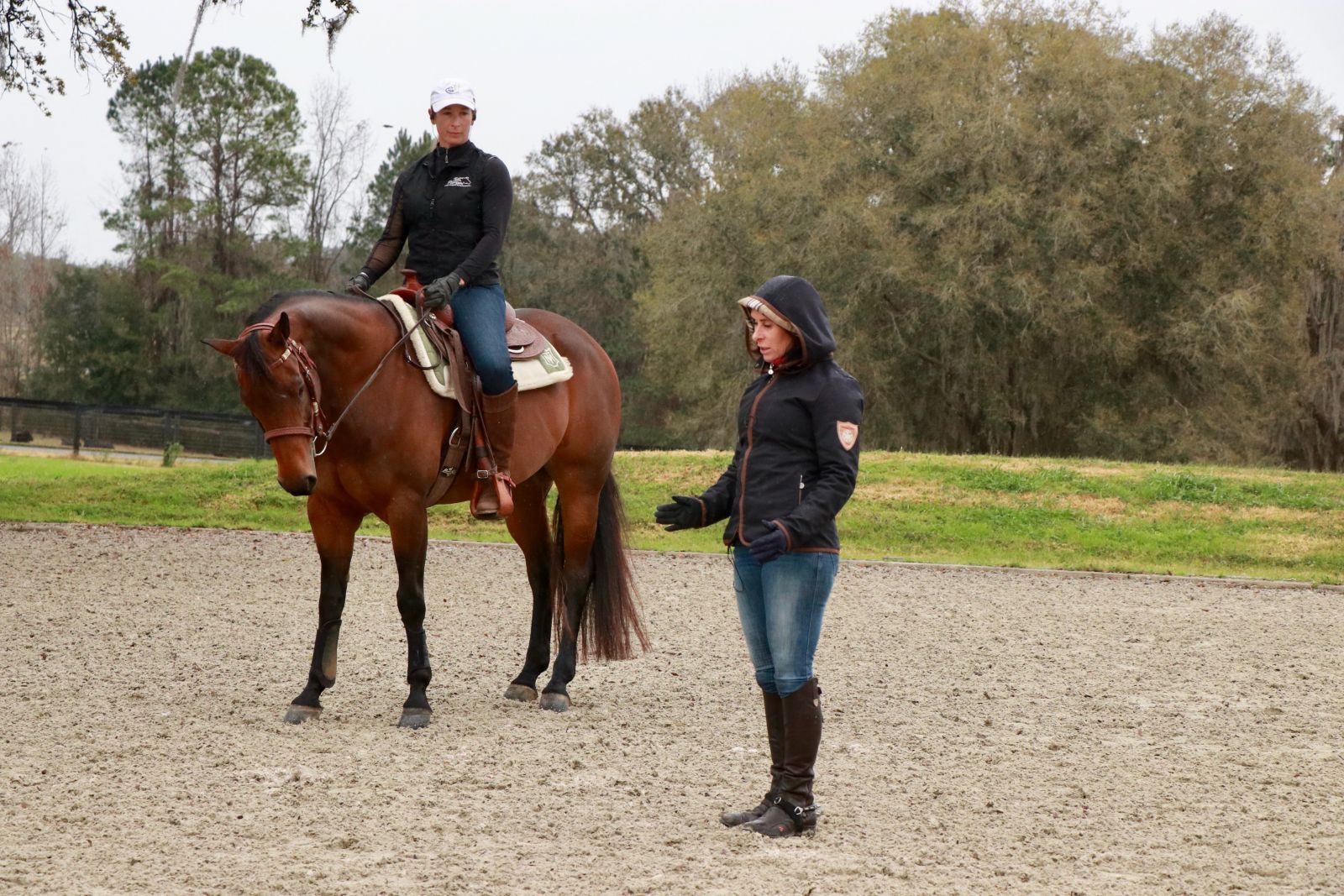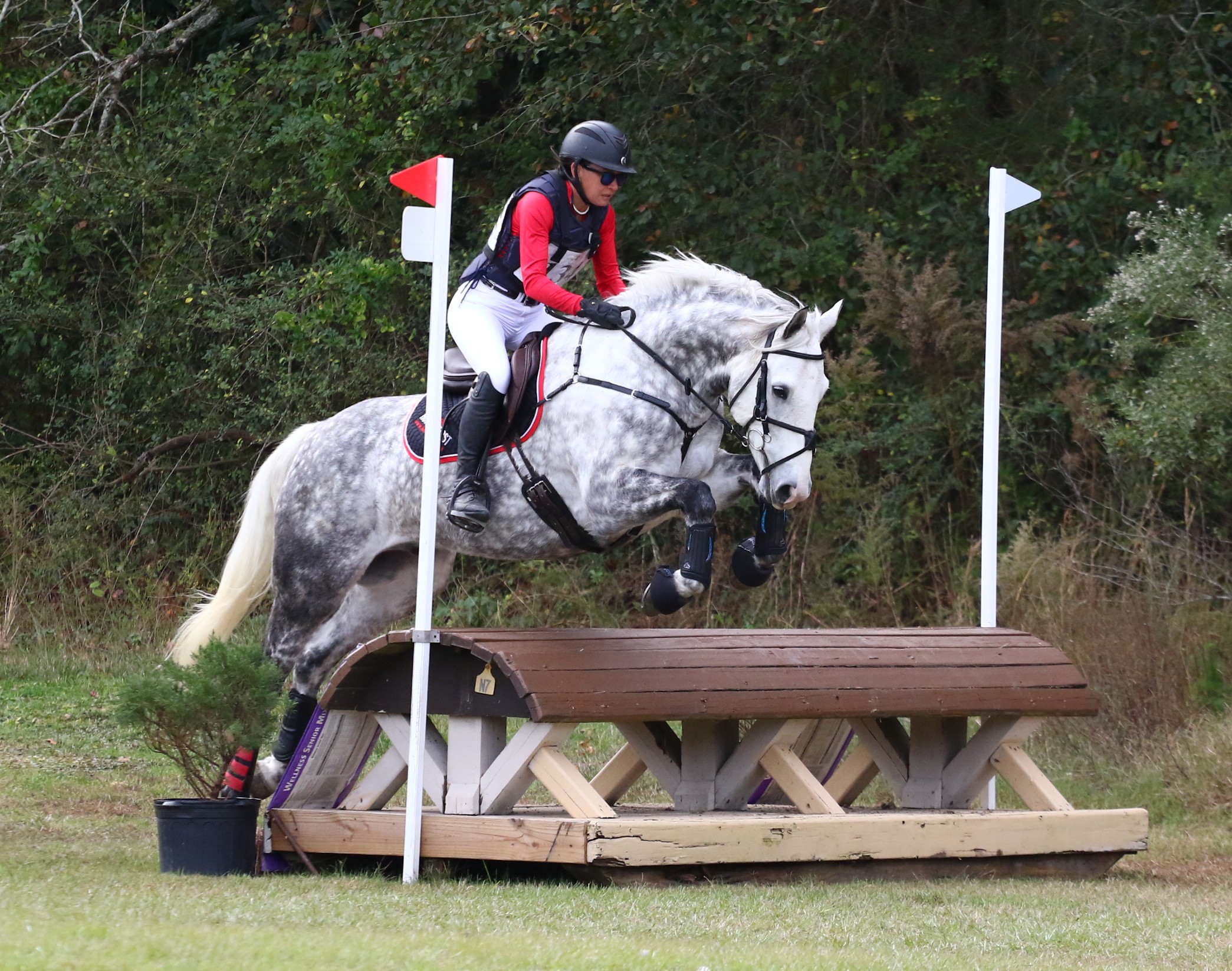 Diego Farje & EQ Scorpio working on building trust.
Diego Farje & EQ Scorpio working on building trust.
This season, we’re following along with Peru’s Diego Farje and his new ride, EQ Scorpio, a part of the newly-formed Equestly Horses program. This series is brought to you in partnership with Equestly, purveyors of the best riding apparel and outerwear out there — trust us, we’ve tested it! To catch up on more Equestly Stories, click here.
When three-year-old EQ Scorpio, owned by Equestly Horses and Diego Farje, walked off the trailer after two days of travel from Argentina to Windurra USA where Diego works as head rider for Boyd Martin, the Argentinian Sport Horse was a little traumatized from the trip. His extremely sensitive and reactive personality meant that the days of travel had been hard on him, causing him to lose weight. When Carlos Hernandez and Sam Potter of Equestly purchased Scorpio, alongside Diego, they were warned that the horse was tough to handle. All of his beautiful jumping talent and gorgeous movement was wrapped up in an outer shell of anxiety that made him reactive and hard to catch, to say the least. Working with him required tenacity that most riders don’t have time for.
In love with the gorgeous 16.2 hand bright bay gelding from the moment he’d seen his auction video, Diego made the time.
He applied several simple techniques and worked hard on his own mindset to build a level of trust and partnership with Scorpio that, while still a work in progress, is impressive for only two months of hard work. Many of us can relate to what it’s like to have a horse that’s anxious and reactive. These horses seem designed to push our buttons, test the limits of our patience, and emotionally exhaust us. Diego’s method of gaining Scorpio’s trust and ensuring that the horse enjoys spending time with him could help so many of us stuck in similar situations.
Diego says that the key to his success is working on his own mindset before handling Scorpio. “It’s not like working with a robot. It’s an entity that feels energy,” Diego said. “I need to be positive even when if I’m exhausted because he feels that, you know? If you have the wrong energy when you work with a sensitive horse, they will feel something weird about you and they won’t want to be close to you.”
No matter what the day has brought him, Diego leaves his stress and emotions at the door and focuses on being positive and calm every time he works with Scorpio, whether he’s just grooming him or putting in a training session. “I’m pretty chill in general. Because of that, he gets calmer and calmer the more I spend time with him. He feels good with me.”

Diego Farje and EQ Scorpio at their first competition at Unionville. Photo by Carlos Hernandéz, COO of Equestly.
This approach doesn’t mean that Diego never sets boundaries with Scorpio. But it does mean that the way he sets those boundaries or corrects the horse is very thoughtful. “If he does something I don’t like, I just make him move with my hand or bump him with the lead rope. Then I tell him that it’s okay and we move on,” Diego said.
Have you ever seen someone reprimand their horse by getting that growly voice and making a really aggressive face that looks like a snarl? Yeah, that doesn’t fly with Diego and Scorpio. “A correction is just a correction,” Diego said. “I’ll just apply pressure and when he gives me something positive I reward him and then we move on. We don’t get feelings involved. We don’t get angry and we don’t make that face that looks like, ‘I’m gonna kill you.’”
With that being said, it’s human nature to get emotional when working with these big animals. Particularly when your horse spooks and you feel like you’re about to get crushed, it’s easy to react with anger out of fear. I know that I’ve been there and done that, even though it’s something I strive to avoid. Diego’s way of handling a spooky, sensitive horse takes fear out of the equation. “I try not to make a big deal out of the little things that he spooks at. If I try to correct him at that moment, he freaks out and makes the situation worse. If I don’t react, he realizes that there’s nothing to worry about,” Diego said. “So the next time he goes through it, he doesn’t even care. If he spooks, I show him, ‘Hey, nothing happened, you’re safe. Just chill out.’ I try to keep my energy pretty neutral.”
Perhaps the key to Diego’s success with using his own emotions (or lack thereof) to calm Scorpio down is the amount of quality time he’s spent with the young horse. When Scorpio first arrived, he was completely shut down. He wouldn’t let anyone approach him and wouldn’t even poke his head out of the stall to look around. Now, Diego can walk into the pasture and Scorpio will come running. How did he get to this point? A lot of patience and horse treats.
Diego has spent hours sitting in Scorpio’s stall waiting for him to approach him. “I used to go into the stall and he was like ‘What are you doing? Like, give me my space.’ But then I just waited for him to approach me. And he was curious, like ‘What’s that? What are you doing?’ Every time he came over I would give him a treat, just to help him feel comfortable,” Diego said. “I think it just takes patience and giving him space and showing him confidence around other people and horses.”
While Scorpio now trusts Diego, it’s still a work in progress with the other barn staff. Despite the setbacks, Diego hasn’t given up and uses everyday activities like grooming and bathing to continue building Scorpio’s trust in him. “I hate when people spray horses in the face with a lot of water pressure. Imagine if you had someone spraying you in the face with a lot of water pressure. You wouldn’t be comfortable,” Diego said. “So, when I first started bathing Scorpio I started working with him to show him that I wasn’t going to spray his eyes or his face. I use less water pressure and put the hose on the back of the crown and just let it run down his head really gently. I want him to think, ‘Oh, actually that feels really good.’ Once he gives me that relaxation with the water running down his face, I stop.”
The spa day and relaxation techniques continue even after bathtime. “In the beginning, he didn’t want me to approach him with a towel. It was terrifying to him,” Diego said. “Now, he rubs his face on it and enjoys when I go over his body with it. He starts chewing and gets really relaxed.”
“After training and bathing, I just put him in a stall and I can feel his energy really low and relaxed,” Diego added. “I really want everything I do with him to create more good experiences with me, you know?”
Diego really prioritizes working with even the smallest of Scorpio’s quirks, instead of trying to force the horse through every single challenge he faces. For example, Scorpio decided he hated having a fan blowing over his head and down at his face. “He just doesn’t like it, and I won’t force it,” Diego said. “Now the fan is in a corner and blows at a diagonal, instead of down on him, so he’s fine with that.”

Diego Farje & EQ Scorpio working on their partnership on the cross country field.
“He’s just hyperaware and really, really sensitive. There’s not another word to describe it. He’s always focused on everything that’s happening around him,” Diego said.
While many riders would take Scorpio’s reactiveness as a negative trait, Diego believes that sensitivity will add to his athletic abilities in the long run. “When he starts really working in his eventing career, he’ll be really focused, right? He’ll have a really fast reaction to a jump and be really sensitive to where his legs are and how to pick them up. I just need to channel that energy and sensitivity in my favor.”
As the owner of a sensitive young Thoroughbred myself, there’s a lot I’ve taken away from Diego’s trust-building process with Scorpio. Not only am I going to be more mindful of my own energy and mindset, but I’m going to put more emphasis on ensuring my horse is taking some enjoyment away from every step of my process. As Diego has proven, sensitive horses require thoughtful and compassionate handling.
Have you checked out the all-new Equestly.Ride app yet? You can download it for free in the Apple App Store (sadly, it’s not currently available on Android – but we’ll keep you posted!). Inside, you can track your rides, make a training schedule, manage your horse’s appointments, and catch up on news from EN — all in one place. Plus, the more you use Equestly.Ride, the more points you’ll earn toward awesome Equestly merchandise and more. Learn more here.




































